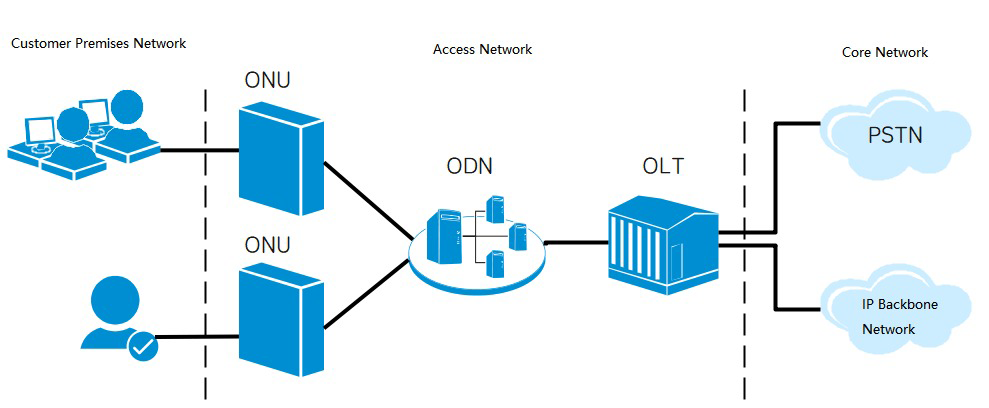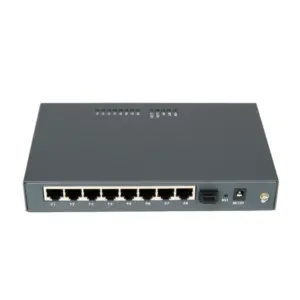Hello everyone! FTTH network is the leading technology in the current optical access field, of which ONU and ODN are two key components and play an indispensable role in ensuring high-speed and reliable fiber-to-the-home services. Today I am very happy to provide you with a comprehensive comparative analysis of the different responsibilities and technical characteristics of ONU and ODN in FTTH networks, to help you gain a deeper understanding of the importance of the two in collaborative work. By comparing the differences between ONU and ODN in terms of hardware structure and bearer services, I believe you will be able to better plan and build your own FTTH network and provide users with an excellent optical access experience.

ONU Overview
Let me introduce you to ONU (Optical Network Unit) technology. If you want to know more about what ONU is, please refer to the article: What is onu: The Definitive Guide to the Best of 2024
Basic functions and features of ONU:
- ONU is the user-side terminal equipment in the FTTH (Fiber To The Home) optical fiber access network.
- The main functions include: converting optical signals into electrical signals and providing business access services.
- Typical features include: integration of multiple business interfaces, high reliability, easy deployment, etc.
- It is a key device that connects users to optical fiber networks.
The position and importance of ONU in the FTTH network architecture:
- ONU is located on the user side of the FTTH network and is responsible for providing access services to users.
- Through ONU, users can access high-speed, high-bandwidth optical fiber networks and enjoy a rich business experience.
- As an important part of the FTTH network, ONU plays a key role in the entire network architecture.
The development history and application status of ONU technology:
- ONU technology has gradually matured with the rise of FTTH networks, and has experienced development from single to multi-functional.
- Initially, it mainly provided basic voice and data services, and later gradually integrated IPTV, VOIP and other services.
- At present, ONU technology has been widely used in FTTH deployments around the world and is an important component of optical fiber access networks.
- With the continuous evolution of PON (Passive Optical Network) standards, ONU equipment is also constantly upgraded.
In general, ONU, as the user terminal equipment in the FTTH network, bears the key task of providing users with high-speed optical access services. With the popularization of FTTH networks, ONU equipment is constantly enriching its functions to meet the diverse business needs of users. ONU’s position in FTTH applications is increasingly prominent.
ODN Overview
Let me introduce you to ODN (Optical Distribution Network) technology. If you want to know more about what ODN is, please refer to the article: What is odn: The Definitive Guide to the Best of 2024
Basic concepts of ODN:
- ODN is the optical distribution network part of the FTTH (Fiber To The Home) optical fiber access network.
- Mainly composed of passive optical components such as optical fibers and optical splitters.
- Its function is to distribute the optical signals of the OLT (Optical Line Terminal) to each user-side ONT (Optical Network Terminal).
The important position of ODN in FTTH network:
- ODN is the key transmission part of FTTH network, located between OLT and ONT.
- Through ODN, flexible allocation and distribution of optical signals can be realized to support access services of the entire network.
- The design and deployment of ODN directly affects the coverage and user access performance of the optical fiber network.
The development history and application status of ODN technology:
- ODN technology continues to advance with the development of FTTH networks, gradually evolving from early point-to-point optical fibers.
- The current mainstream adoption is the splitter-based Passive Optical Network (PON) architecture.
- ODN technology has been widely used in FTTH deployments around the world and is the key to building optical fiber access networks.
- With the continuous upgrading of PON standards, ODN technology is also constantly optimized and innovated.
In general, ODN, as the optical distribution part of the FTTH network, plays an indispensable role in the entire access network architecture. Optimizing the design and deployment of ODN is crucial to improving the performance and user experience of FTTH networks. As optical fiber access technology continues to advance, ODN technology will continue to innovate and develop.
Technical comparison between ONU and ODN
Let me compare the technical differences between ONU (Optical Network Unit) and ODN (Optical Distribution Network) from the following aspects:
Hardware structure and interface type:
- ONU is a terminal device that integrates a variety of user-side interfaces, such as Ethernet, voice, etc.
- ODN is mainly composed of passive optical components such as optical splitters, optical fiber cables, etc., and does not contain active electronic components.
- ONU requires power supply, while ODN completely uses passive optical technology.
Bearer service and performance indicators:
- ONU is responsible for providing business access services to end users, such as voice, video, data, etc.
- ODN is mainly responsible for the transmission and distribution functions of optical signals and does not involve specific business processing.
- ONU needs to support more business types and interfaces, and has higher performance requirements.
Network location and functional positioning:
- ONU is located at the user-side terminal of the FTTH network and is directly connected to the user equipment.
- ODN is located between the OLT and ONU and is responsible for the relay and distribution of optical signals.
- ONU provides service access, while ODN ensures the normal operation of optical transmission channels.
Their collaborative working mechanism:
- ONU and ODN work together to build a complete FTTH optical fiber network.
- ONU receives the optical signal from the OLT through the ODN, and converts it into an electrical signal to provide to the user.
- ODN is responsible for reliably distributing the optical signals of the OLT to the ONU terminal equipment on each user side.
It is not difficult to see from the above that ONU and ODN each play different functional roles in the FTTH network. As a user-side terminal, ONU provides service access; while ODN is responsible for the basic tasks of optical signal transmission and distribution. The two work together through standardized interfaces to jointly realize the overall functions of the FTTH network.
The role of ONU and ODN in FTTH network
Let me further introduce to you the important role of ONU and ODN in FTTH (Fiber To The Home) optical fiber access network:
The key role of ONU in providing access services on the user side:
- ONU, as the user-side terminal equipment of the FTTH network, is directly responsible for providing access services to users.
- ONU can convert optical signals into electrical signals that can be recognized by users, supporting multiple services such as voice, video, and data.
- The functional integration, reliability, ease of deployment, etc. of ONU equipment directly affect the user experience.
- ONU is a key link in the final service delivery of the FTTH network.
The core functions of ODN in optical transmission and distribution:
- ODN, as the optical distribution network part of the FTTH network, undertakes the basic tasks of optical signal transmission and distribution.
- ODN is composed of passive optical components such as optical fibers and optical splitters, providing reliable optical transmission channels.
- The design and deployment of ODN directly determines the coverage and user access performance of the FTTH network.
- ODN is a key component in building a complete FTTH network.
The importance of ONU and ODN working together to realize fiber-to-the-home:
- ONU and ODN work together through standardized interfaces to jointly build the end-to-end transmission system of the FTTH network.
- The synergy between the two ensures the efficient and stable operation of the entire optical access network.
- Provides users with high-speed and rich fiber-optic broadband services, greatly improving user experience.
- Promoted the widespread deployment of FTTH networks around the world and promoted the process of fiber-to-the-home.
To sum up, ONU and ODN each perform their own duties in the FTTH network and share the responsibility of providing users with high-quality optical fiber access services. The collaborative work of the two is the key to the realization and sustainable development of FTTH networks. The important position of ONU and ODN in FTTH applications is irreplaceable.
Summary
ONU and ODN are two key components in the FTTH network. Although there are differences in hardware design and carrying functions, they play an inseparable and important role in collaborative work. ONU provides access ports and services on the user side, while ODN assumes the core tasks of optical transmission and distribution. The two work together to build a solid foundation for FTTH networks through efficient cooperation.
We provide professional ONU and ODN products and FTTH network planning services, and have an experienced technical team to provide you with considerate guidance at any time. If you have any needs during the construction and maintenance of FTTH network, please feel free to contact us for communication.
ONU and ODN FAQ
An ONU is a device used in passive optical networks (PONs) to terminate the optical signal and convert it into electrical signals for communication with end-user devices such as computers, phones, and routers.
An ODN refers to the passive optical infrastructure that includes fiber optic cables, splitters, connectors, and distribution points used to distribute optical signals from the central office (OLT) to subscriber premises (ONT/ONU).
The key functions of an ONU include receiving optical signals from the OLT, converting them into electrical signals for user devices, providing interfaces (such as Ethernet ports, phone jacks), and managing the communication between the subscriber and the service provider’s network.
An ODN comprises fiber optic cables, passive optical splitters, connectors, distribution boxes, and termination points, forming the infrastructure for distributing optical signals within a passive optical network (PON).
Data flows between an ONU and the OLT via optical signals transmitted over fiber optic cables within the ODN. The ONU receives downstream data (from the network to the subscriber) and sends upstream data (from the subscriber to the network) to the OLT.
ONUs can deliver various services, including high-speed internet access (e.g., GPON, XGS-PON), voice services (VoIP), video streaming, IPTV (Internet Protocol Television), cloud services, and enterprise connectivity.
The key components of an ODN include fiber optic cables (single-mode or multimode), optical splitters/combiners (for splitting or combining optical signals), connectors (SC, LC, etc.), distribution boxes, and termination points.
Deployment considerations include network capacity planning, coverage area, fiber optic infrastructure readiness, compatibility with subscriber devices, service provisioning, scalability, and network management capabilities.
Yes, ONU and ODN technologies adhere to standards set by organizations like the International Telecommunication Union (ITU) and the Institute of Electrical and Electronics Engineers (IEEE) to ensure interoperability, performance, and compatibility with different network architectures.
ONU and ODN are commonly used in fiber-to-the-home (FTTH), fiber-to-the-building (FTTB), and fiber-to-the-premises (FTTP) deployments by telecommunications companies, internet service providers (ISP), and network operators to deliver high-speed broadband connectivity and services to residential, commercial, and enterprise customers.
GPON ONU Related Product
-
2-port Gigabit+100M+WIFI phone port XPON ONU
-
2-port Gigabit+100M+WIFI XPON ONU
-
2-port Gigabit+WIFI phone port XPON ONU
-
4-port 100M GPON ONU
-
4-port 100M GPON POE ONU
-
4-port Gigabit GPON ONU
-
4-port Gigabit GPON POE ONU
-
8-port 100M GPON ONU
-
8-port 100M GPON POE ONU






















